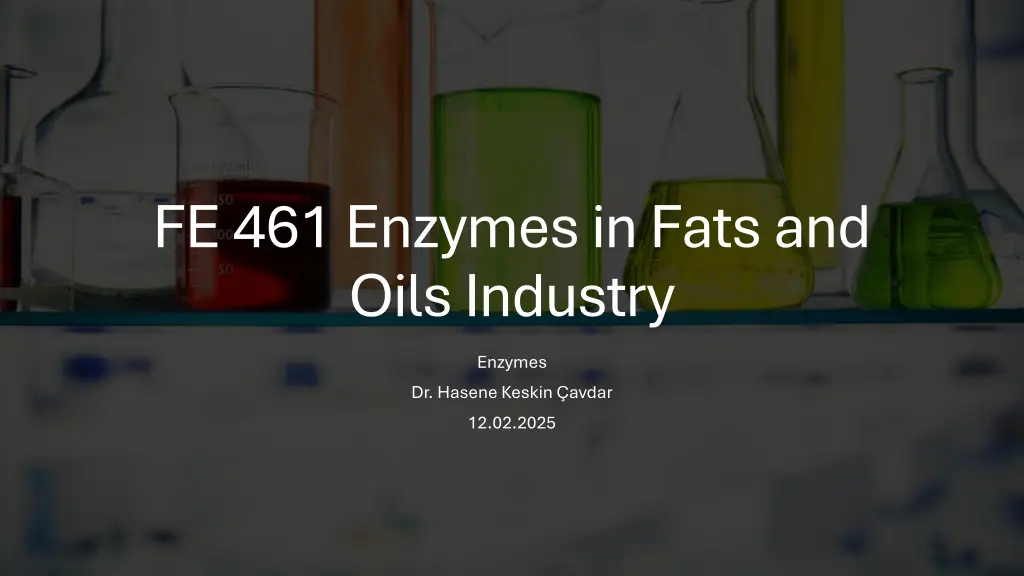
Enzymes in Fats and Oils Industry: Importance and Applications
Discover the significance of enzymes in the fats and oils industry, how they speed up chemical reactions, and their essential roles in biology and industrial applications. Explore the structure, functions, and benefits of enzymes, and learn why they are crucial for metabolism, digestion, and various industrial processes.
Download Presentation

Please find below an Image/Link to download the presentation.
The content on the website is provided AS IS for your information and personal use only. It may not be sold, licensed, or shared on other websites without obtaining consent from the author. If you encounter any issues during the download, it is possible that the publisher has removed the file from their server.
You are allowed to download the files provided on this website for personal or commercial use, subject to the condition that they are used lawfully. All files are the property of their respective owners.
The content on the website is provided AS IS for your information and personal use only. It may not be sold, licensed, or shared on other websites without obtaining consent from the author.
E N D
Presentation Transcript
FE 461 Enzymes in Fats and Oils Industry Enzymes Dr. Hasene Keskin avdar 12.02.2025
Whyenzymes? Thousands of different chemical reactions must happen inside a cell every second in order for it to function. If these cellular reactions happen too slowly, the cell may die. If the cell is part of a larger multicellularorganismthen thismight harm the wholeindividual. Chemical reactions can be speeded up by increasing the temperature because more molecules will have sufficient energy to react with each other. However, increasing temperature will cause damage to cells. Livingcellssolvethis problem by producingproteins called enzymes.
Enzymes can speed up the break down of complex molecules into simpler molecules or the building up of simple molecules into more complex molecules.
Introduction to Enzymes What are Enzymes? What are Enzymes? Biological catalysts that speed up chemical reactions. Mostly proteins (some RNA molecules act as enzymes, e.g., ribozymes). Key Properties: Key Properties: Highly specific to their substrates. Not consumed in reactions (can be reused). Work under mild physiological conditions (temperature, pH). Importance in Biology & Industry: Importance in Biology & Industry: Essential for metabolism, digestion, and DNA replication.
Importanceof Enzymes Biological Biological Functions Essential for metabolism (breaking down and synthesizing molecules). Aid in digestion (e.g., amylase, protease, lipase). Support DNA replication & repair. Industrial Industrial Applications: Applications: Food industry (cheese-making, brewing, baking). Pharmaceutical industry (drug synthesis, disease diagnostics). Textile & detergent industry (biodegradable stain removers). Environmental Environmental Benefits Benefits: : Biodegradable and eco-friendly alternatives to chemicals. Help in waste treatment and biofuel production. Functions: :
Structureof Enzymes Enzymes are proteins. Their folded chains of amino acids can be represented by simple shapes. 1. Apoenzyme (Protein Part) Themain protein component, responsibleforenzymespecificity. 2. Active Site: A specificregionwherethe substrate binds andreactionoccurs. 3. Cofactors & CoenzymesCofactors: Inorganicmolecules(e.g., metal ionslikeZn , Mg ).Coenzymes: Organicmolecules(e.g., vitamins likeB-complex). 4. Holoenzyme(Active Form)Apoenzyme+ Cofactor/Coenzyme= Fullyfunctionalenzyme.
Active site The active site is the region that binds the substrates (& cofactors if any) It contains the residues that directly participate in the making & breaking of bonds The interaction of the enzyme and substrate at the active site promotes the formation of the transition state The active site is the region that most directly lowers the Free Energy of the reaction and activation energy resulting in rate enhancement of the reaction 3-Dimensional structure
Enzyme Specificity Introduction What is Enzyme Specificity? The ability of an enzyme to recognize and bind to a specific substrate. Ensures precise biochemical reactions. Enzymes are specific because different enzymes have differently shaped active sites. The shape of the active site of an enzyme is complementary to the shape of its specific substrate. This means they are the correct shapes to fittogether.
Types of Enzyme Specificity 1 Absolute Specificity Enzyme acts on only one substrate (e.g., Urease Urea). 2 Group Specificity Enzyme acts on a specific functional group (e.g., Alcohol Dehydrogenase Alcohols). 3 Linkage Specificity Recognizes a specific type of bond (e.g., Proteases Peptide Bonds). 4 Stereochemical Specificity Distinguishes between different isomers (e.g., Lactic Acid Dehydrogenase L-Lactate).
How enzymes catalysebiological reactions? The diagram belowshowshowan enzymecatalyses the breakdown ofonesubstrate into two products.
Enzyme-Substrate Complex What is the Enzyme What is the Enzyme- -Substrate Complex? Substrate Complex? A temporary structure formed when the enzyme binds to its specific substrate. Critical for catalyzing biochemical reactions efficiently. Steps in Formation: 1. Substrate Binding The substrate attaches to the enzyme's active site. 2. Enzyme-Substrate Complex Formation The enzyme stabilizes the substrate in the correct orientation. 3. Catalysis The reaction occurs, converting the substrate into products. 4. Product Release The enzyme releases the product and remains unchanged.
Mode of Action of Enzymes: Lock-and-Key (ES) Model This model assumes that the active site of the enzyme and the substrate fit perfectly into one another such that each possesses specific predetermined complementary geometric shapes and sizes. This specificity is analog to the lock and key model, where the lock is the enzyme, and the key is the substrate. This model supposes the enzyme is a rigid structure whose shape does not change upon binding with a suitable substrate.
Mode of Action of Enzymes Induced Fit (ES) Model In this model, the active site can change shape slightly to accommodate substrates with similar shapes and charges. The induced fit model accounts for conformational alterations that occur during binding and enable interactions between proteins with various degrees of shape complementarity in the unboundstate. Thus, the name induced fit model is termed so for the induced small change of active site of an enzyme such that substrate can achieve optimal fit. This configuration change catalyzes the reaction, meanwhile lowering the activation energy barrier and resulting in an increase in the overall rate of the reaction.
